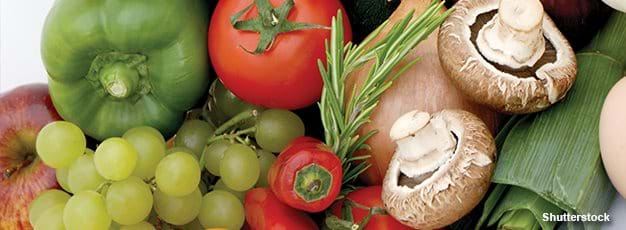A Wide Variety of Fruit and Vegetables Are Affordable for SNAP Recipients

The 2010 Dietary Guidelines for Americans recommends increased vegetable and fruit intake and a variety of vegetables, especially dark-green vegetables, red and orange vegetables, and beans and peas. As demonstrated by ChooseMyPlate.gov, fruit and vegetables should account for about half of a consumer's plate. But can participants in USDA's Supplemental Nutrition Assistance Program (SNAP) afford a wide selection of fruit and vegetables or just the few least expensive types? Recent ERS research suggests that low-income Americans can meet the Dietary Guidelines for fruit and vegetable consumption with a wide selection of fresh and processed products and stay within a limited budget.
Using ERS's 2008 Fruit and Vegetable Prices database, researchers assembled a selection of fruit and vegetables that satisfy the 2010 Dietary Guidelines and do not exceed a budget based on USDA's Thrifty Food Plan (TFP). The TFP demonstrates how people with limited resources can acquire a nutritious diet at a minimal cost. For a family of four, the weekly TFP food budget in 2008 was $135.80, of which $54.32, or 40 percent, was earmarked for fruit and vegetables.
A moderately active family of four following the Dietary Guidelines would need to consume a total of 53 cups of fruit and 74 cups of vegetables per week. The Dietary Guidelines report fruit and vegetable recommendations in cup equivalents--generally the amount of edible food needed to fill a measuring cup. In their calculations, ERS researchers allotted an additional 10 percent in purchased quantities to account for household food losses, such as spoilage and other factors, with the potential to lower consumption. Likewise, USDA food plans for lower income Americans assume that 5 to 10 percent of edible food is not consumed.
The resulting sample list of fruit and vegetables is an example of a combination that meets the Dietary Guidelines within the TFP budget. The list consists of many produce items costing less than 50 cents per cup equivalent--about one-third of the 153 items in the 2008 ERS database. Due to package sizing, the SNAP household in this case actually bought more vegetables than it needed for the week but stayed within its budget.
By choosing lower cost items, such as potatoes, apples, and bananas, a household also could afford some higher cost items. This sample list includes a few items that cost more than 50 cents a cup, such as grape tomatoes and cantaloupe. Another household might choose to purchase freshly squeezed orange juice and economize somewhere else.
| Products (units bought) | Total cup equivalents* (number) | Total retail cost (dollars) |
|---|---|---|
| Fruit | ||
| Apples, fresh (9) | 15.6 | 4.33 |
| Cantaloupe, fresh (1)** | 3.6 | 2.28 |
| Oranges, fresh (4) | 3.0 | 1.03 |
| Bananas, fresh (4) | 2.2 | 0.47 |
| Raisins, 12-oz bag (1) | 4.7 | 1.82 |
| Pears, 15.25-oz can (3)** | 5.2 | 3.00 |
| Orange juice, 12-oz frozen concentrated (4) | 24.0 | 6.12 |
| Vegetables | ||
| Romaine hearts, fresh (3) | 5.9 | 2.38 |
| Broccoli florets, fresh, 12-oz bag (1)** | 2.2 | 1.38 |
| Whole kernel corn, 15-oz can (3) | 5.3 | 1.94 |
| Potatoes, boiled from fresh, peeled (10) | 15.7 | 3.02 |
| Green peas, frozen, 1-lb bag (1)** | 2.6 | 1.34 |
| Green pepper, fresh (1)** | 0.8 | 0.68 |
| Cabbage, boiled or steamed (1) | 5.3 | 1.43 |
| Onions, fresh (3) | 2.6 | 0.74 |
| Celery, fresh 1.5-lb bag (1) | 4.1 | 1.35 |
| Cauliflower, raw (1) | 7.1 | 2.20 |
| Baby carrots, 1-pound bag (3) | 10.6 | 4.20 |
| Sweet potatoes, boiled from fresh (4) | 3.3 | 1.43 |
| Tomatoes, 14.5-oz can (5) | 8.6 | 3.49 |
| Tomatoes, grape, 1 pint (2)** | 3.4 | 4.14 |
| Red bell pepper, fresh (1)** | 0.8 | 1.10 |
| Navy beans, 15.5-oz can (2) | 3.4 | 1.59 |
| Pinto beans, 15.5-oz can (3) | 5.2 | 1.98 |
| Total fruit | 58.3 | 19.05 |
| Total vegetables | 86.9 | 34.39 |
| Total fruit and vegetables | 145.2 | 53.44 |
| Notes: The family of four includes a male and a female age 40, one boy age 10, and one girl age 7. *A cup equivalent is the edible portion that will generally fit in a 1-cup measuring cup. For lettuce and other raw leafy greens, it is the amount that will fit in 2 cups; and for raisins and other dried fruit, it is the amount that will fit in ½ cup. **Costs more than 50 cents per cup equivalent. Source: USDA, Economic Research Service. |
||
"Can Low-Income Americans Afford to Satisfy MyPyramid Fruit and Vegetable Guidelines?", Journal of Nutrition Education and Behavior, 43:173-9, July 2011, by Hayden Stewart, Jeffrey Hyman, Elizabeth Frazão, and Andrea Carlson
Fruit and Vegetable Prices, by Hayden Stewart and Jeffrey Hyman, USDA, Economic Research Service, May 2024

